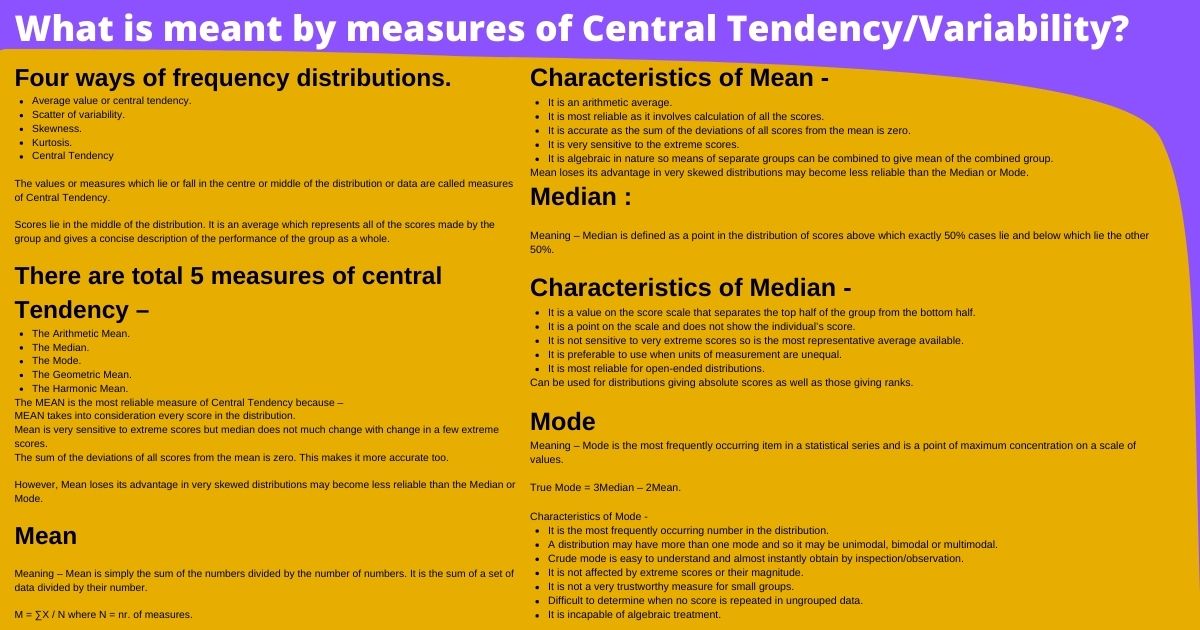Measures of central tendency
by Yuvi - September 28, 2022
What is meant by measures of Central Tendency/Variability?
Why are they so called?
What are the measures of Central Tendency/Variability?
Out of these which one is the most reliable and why?
Four ways of frequency distributions.
- Average value or central tendency.
- Scatter of variability.
- Skewness.
- Kurtosis.
Central Tendency
The values or measures which lie or fall in the centre or middle of the distribution or data are called measures of Central Tendency.
Scores lie in the middle of the distribution. It is an average which represents all of the scores made by the group and gives a concise description of the performance of the group as a whole.
There are total 5 measures of central Tendency –
- The Arithmetic Mean.
- The Median.
- The Mode.
- The Geometric Mean.
- The Harmonic Mean.
The MEAN is the most reliable measure of Central Tendency because –
- MEAN takes into consideration every score in the distribution.
- Mean is very sensitive to extreme scores but median does not much change with change in a few extreme scores.
- The sum of the deviations of all scores from the mean is zero. This makes it more accurate too.
However, Mean loses its advantage in very skewed distributions may become less reliable than the Median or Mode.
Mean
Meaning – Mean is simply the sum of the numbers divided by the number of numbers. It is the sum of a set of data divided by their number.
M = ∑X / N where N = nr. of measures.
Characteristics of Mean –
- It is an arithmetic average.
- It is most reliable as it involves calculation of all the scores.
- It is accurate as the sum of the deviations of all scores from the mean is zero.
- It is very sensitive to the extreme scores.
- It is algebraic in nature so means of separate groups can be combined to give mean of the combined group.
- Mean loses its advantage in very skewed distributions may become less reliable than the Median or Mode.
Uses of Mean –
- When greatest reliability is wanted.
- When further arithmetical computations like standard deviation and correlation are to be done.
- When distribution is symmetrical about the centre. Eg. NPC.
- When we wish to know centre of gravity of the sample.
Median
Meaning – Median is defined as a point in the distribution of scores above which exactly 50% cases lie and below which lie the other 50%.
Characteristics of Median –
- It is a value on the score scale that separates the top half of the group from the bottom half.
- It is a point on the scale and does not show the individual’s score.
- It is not sensitive to very extreme scores so is the most representative average available.
- It is preferable to use when units of measurement are unequal.
- It is most reliable for open-ended distributions.
- Can be used for distributions giving absolute scores as well as those giving ranks.
Uses of Median –
- To get exact mid-point of distribution.
- To avoid influence of extreme scores.
- More reliable when upper or lower class interval is of unspecified length.
- To know simply whether cases fall in upper or lower half of the distribution and not interested in knowing distance from a point.
- Appropriate when distribution is in terms of percentiles.
Mode
Meaning – Mode is the most frequently occurring item in a statistical series and is a point of maximum concentration on a scale of values.
True Mode = 3Median – 2Mean.
Characteristics of Mode –
- It is the most frequently occurring number in the distribution.
- A distribution may have more than one mode and so it may be unimodal, bimodal or multimodal.
- Crude mode is easy to understand and almost instantly obtain by inspection/observation.
- It is not affected by extreme scores or their magnitude.
- It is not a very trustworthy measure for small groups.
- Difficult to determine when no score is repeated in ungrouped data.
- It is incapable of algebraic treatment.
Uses of Mode –
- Mode is useful when a quick and approximate measure of central tendency is required.
- When information regarding the most typical case (i.e. the most frequently occurring case) is wanted.











